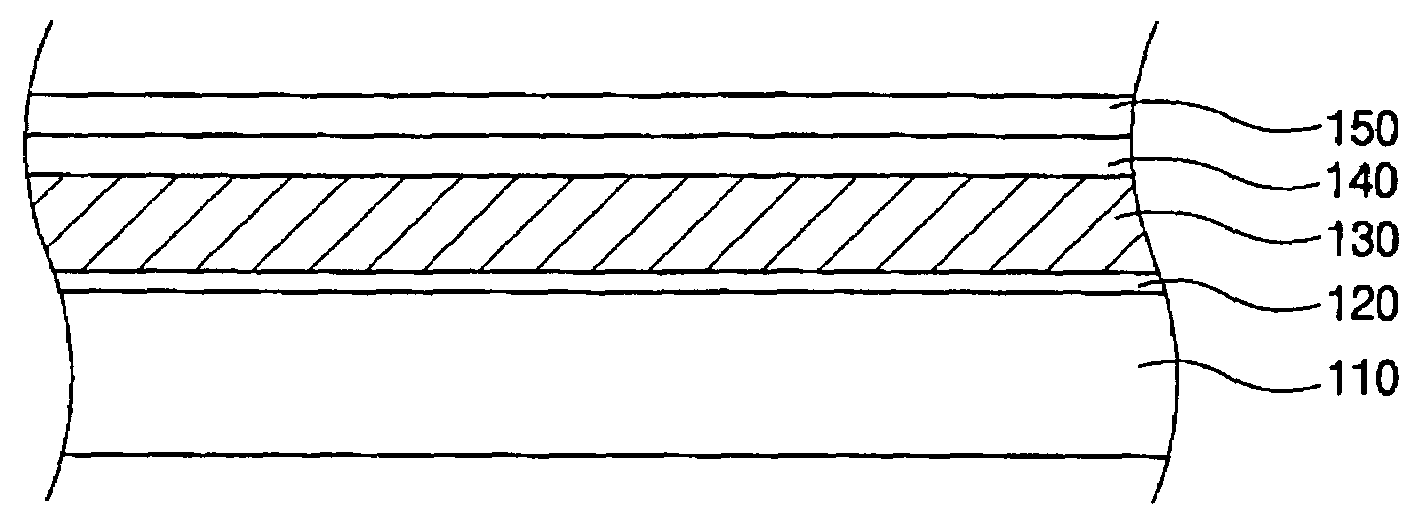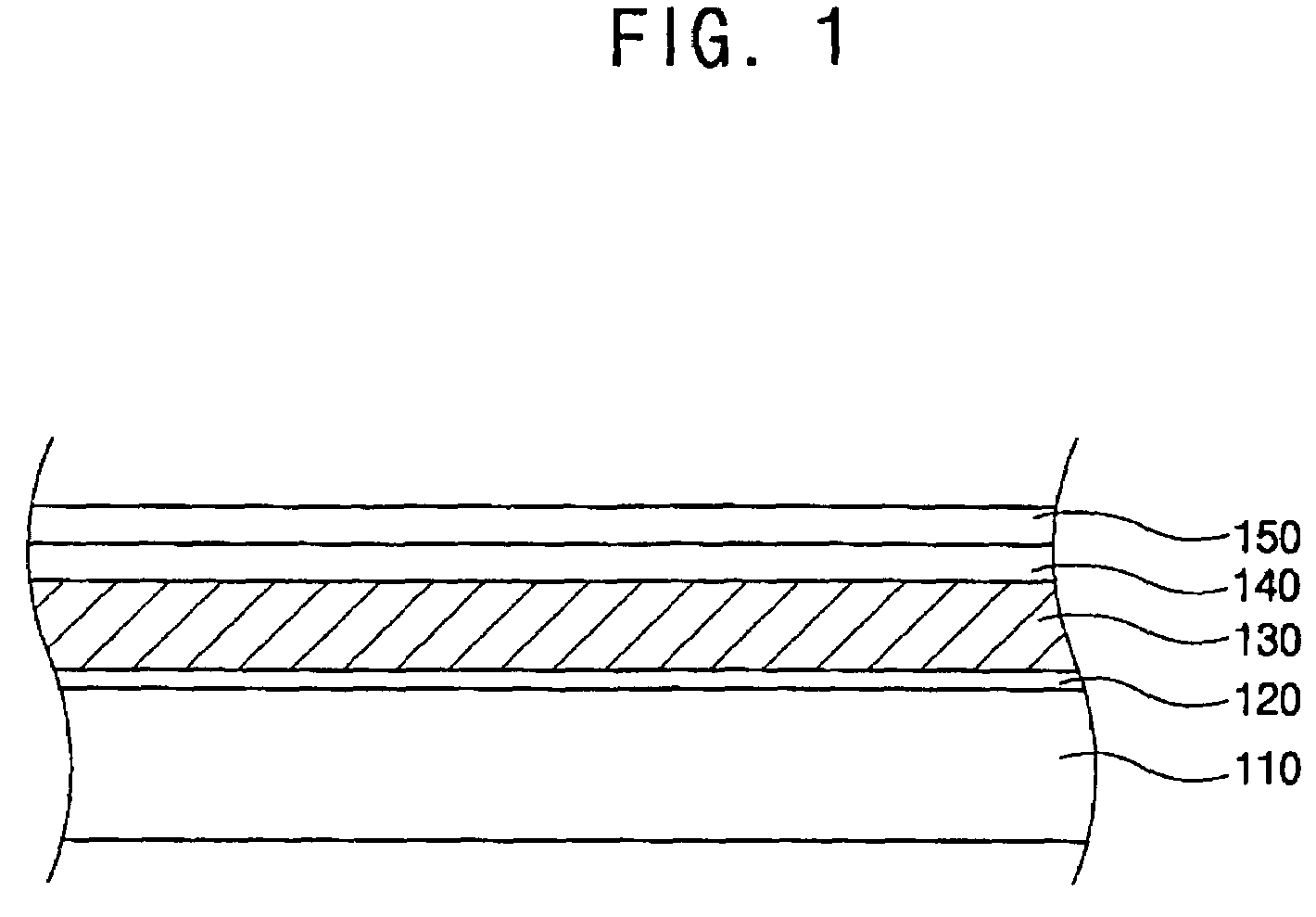Electroluminescent polymer nanocomposite material, method of manufacturing the same and organic light emitting display apparatus having the same
a technology of electroluminescent nanocomposite materials and nanocomposite materials, which is applied in the direction of non-metal conductors, discharge tubes luminescnet screens, conductors, etc., can solve the problems of extreme limitation in the selection of initial molecule structures of cyanine dyes for the formation of nanocrystalline phases, poor solubility of salt-like compounds, and the lik
- Summary
- Abstract
- Description
- Claims
- Application Information
AI Technical Summary
Benefits of technology
Problems solved by technology
Method used
Image
Examples
specific example 1
[0017]An electroluminescent polymer nanocomposite material based on J-aggregates was prepared as follows. A predetermined amount of polyaniline was dissolved in water on the basis of about 99.5 wt. % of polyaniline to about 0.5 wt. % of a cyanine dye (3,3′-di(γ-sulfopropyl)-9-ethyl-5,5′-dichloroxacarbocyanine triethylammonium salt having a electroluminescence spectrum with a maximum at about 575 nm or 3,3′-di(γ-sulfopropyl)-9-ethyl-5,5′-dimethoxythiacarbocyaninepyridinium triethylammonium salt having a electroluminescence maximum at about 675 nm). Then, a powder of the cyanine dye in the amount indicated above was introduced into the solution of polyaniline at room temperature. The solution changed color resulting from the transition of the cyanine dye molecules into the nanocrystalline phase. The process was controlled spectrophotometrically. Prior to spin-coating the solution onto the current-conducting substrate, the substrate was thoroughly cleaned in an ultrasound bath containi...
specific example 2
[0019]An electroluminescent polymer nanocomposite material based on J-aggregates was prepared as follows. A predetermined amount of polyaniline was dissolved in water on the basis of about 50 wt. % of polyaniline to about 50 wt. % of a cyanine dye (3,3′-di(γ-sulfopropyl)-4,5,4′,5′-dibenzo-11-diphenylamino-10,12-dimethylenethiacarbocyaninebetain triethylammonium salt having a electroluminescence spectrum with a maximum at about 1100 nm). Then, a powder of the cyanine dye in the amount indicated above was introduced into the solution of polyaniline at room temperature. Prior to sprinkling the solution onto the current-conducting substrate, the substrate was thoroughly cleaned. Glass plates were used as the substrates and were coated with a transparent layer of In2O3 / SnO2 having a resistance in the range of about 16 to about 20 Ohms / square. Prior to sprinkling the solution, the plates were successively cleaned in an ultrasound bath containing a detergent solution, in a mixture of isopr...
specific example 3
[0020]An electroluminescent polymer nanocomposite material based on J-aggregates was prepared as follows. A predetermined amount of polyaniline was dissolved in water on the basis of about 50 wt. % of polyaniline to about 50 wt. % of a cyanine dye. Then, a powder of the cyanine dye in the amount indicated above was introduced into the solution of polyaniline at room temperature. The solution changed color resulting from the transition of the cyanine dye molecules into the nanocrystalline phase of J-aggregates. The process was controlled spectrophotometrically. When using the above indicated amount of dye, dimers may form simultaneously with the J-aggregates in the solutions. Consequently, the dimers impaired the spectral characteristics of the composites, which was evidenced by a loss of color saturation in the electroluminescence spectrum caused by superposition of the radiation band of the dimers. In order to convert the dimeric form of the cyanine dyes into the nanocrystalline ph...
PUM
| Property | Measurement | Unit |
|---|---|---|
| temperature | aaaaa | aaaaa |
| temperature | aaaaa | aaaaa |
| temperature | aaaaa | aaaaa |
Abstract
Description
Claims
Application Information
 Login to View More
Login to View More - R&D
- Intellectual Property
- Life Sciences
- Materials
- Tech Scout
- Unparalleled Data Quality
- Higher Quality Content
- 60% Fewer Hallucinations
Browse by: Latest US Patents, China's latest patents, Technical Efficacy Thesaurus, Application Domain, Technology Topic, Popular Technical Reports.
© 2025 PatSnap. All rights reserved.Legal|Privacy policy|Modern Slavery Act Transparency Statement|Sitemap|About US| Contact US: help@patsnap.com


